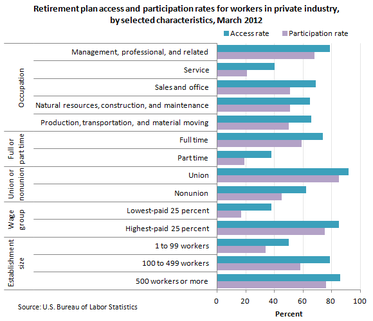|
6/18/2014 0 Comments Participants on Steady CourseVanguard for over a decade has been providing valuable data on retirement plan participant trends, based on its own client base. The latest edition, How America Saves 2014: A Report on Vanguard 2013 Defined Contribution Plan Data, for the most part shows steady progress. A few of the highlights:
What we see from the Vanguard data is a growing, strong preference by many participants for assistance in getting them to a better place in saving for retirement. Most participants recognize that they are not financial experts. The professionally managed and auto-enrollment data would appear to reconfirm that as well.
0 Comments
8/29/2013 0 Comments Healthcare Industry Retirement Plans Adjust to Changes; Older Employees Take to WebRecent legislation and a flurry of merger & acquisition (M&A) activity have led to dynamic changes in the healthcare industry. The Affordable Care Act (ACA) is resulting in many healthcare employers reexamining their organizational structures and operations. The related pharmaceutical industry similarly has seen significant M&A momentum. Fidelity has released a report, Defining Excellence: Plan Design and Retirement Readiness in the Not-For-Profit Healthcare Industry, that focuses on the challenges faced by these plan sponsors. Data was gathered from 600+ plans serviced by Fidelity, representing about 2 million participants and $72 billion in plan assets. One particularly interesting trend reported by Fidelity is that as employee tenure increases, the gap in participation levels tends to narrow between those in plans with automatic enrollment (AE) and those in plans without AE. While this result is somewhat to be expected as few tend to opt out of participating in their employer's plan, what is notable is that the gap never fully closes, even for employees with 25+ years with their employer. In AE plans, the participation rate hovers within four percentage points on either side of 80%, regardless of tenure. By contrast, in non-AE plans, the participation rate for employees with one to three years of tenure is only 35%. This does improve to 70% for those with 25+ years, but still falls short of the 84% for those in AE plans with a similar tenure.
Surfing Boomers. Another interesting finding in the Fidelity study is that across all age groups except those 70+, participants preferred engaging with their plan through Fidelity's participant website than via phone. The level is very consistent for those in their 30's through those in their 60's, with a slight uptick as one approaches age 65. WIth the continued growth of the smartphone and tablet markets, it would appear that access through a portal will remain strong for the foreseeable future.  The Bureau of Labor Statistics has released its latest update on the degree of access to and participation in retirement plans by private industry workers. As of March 2012, 65% of private industry workers had access and 48% participated. Access and participation are significantly higher for professional and managerial employees as compared to those in the service industries. Similar trends are found for union vs. non-union members, full-time vs. part-time, higher-paid vs. lower-paid, and large companies vs. small companies.The attached chart and its related data are from the BLS website at http://www.bls.gov/opub/ted/2012/ted_20120921.htm The Society of Actuaries (SOA) has released a new report, Key Findings and Issues: Working in Retirement, focused on its 2011 Risks and Process of Retirement study. Among the key findings:
The July 2012 Working in Retirement report is available on SOA's website at http://www.soa.org/files/research/projects/research-key-finding-working-retire.pdf The Government Accountability Office has released a 96-page report, Retirement Security: Women Still Face Challenges. The GAO notes that while women's access to and participation in retirement plans has improved over the past decade relative to men, women contributed to their DC plans at lower levels than did men. For those women in or near retirement, divorce, widowhood, or unemployment tended to have an adverse effect on retirement income security. The full report is available on the GAO's website at http://www.gao.gov/assets/600/592726.pdf.
|
Blog Author - Ken FelsherWith over 25 years of writing, editing, and research experience. I enjoy sharing with my readers my love of working with content on a variety of subjects. CategoriesAll 401(k) 402(g) Boomers Catch-up DB Dc Deferral Limit Defined Benefit Defined Contribution ERISA Healthcare Participation Pension Professionally Managed RCS Retirement Retirement Confidence Tax Code Vanguard Women Working Archives
March 2015
|
